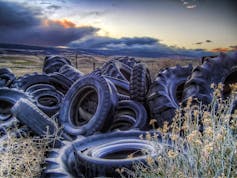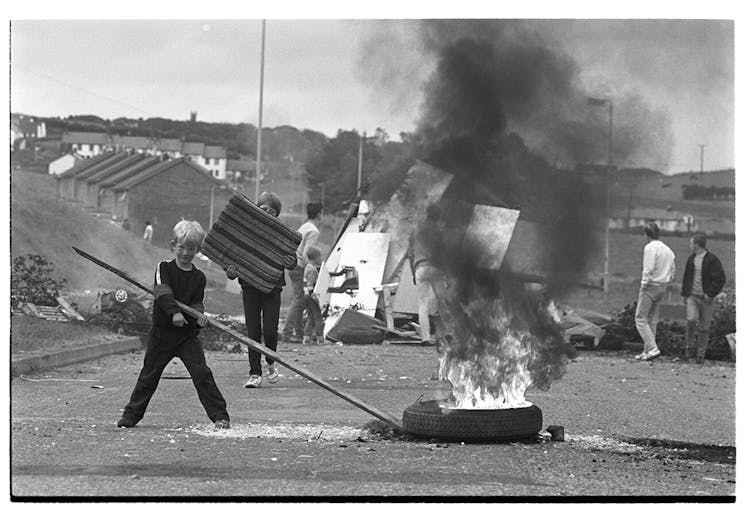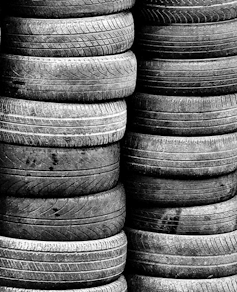Used tyres pose a major environmental risk around the world, with more than one billion tyres disposed of every year. Most of these tyres end up in landfill.
Estimates suggest more than 20 million passenger tyres require disposal in Australia each year. Only 23% of these tyres are recycled. A huge 64% are landfilled and roughly 14% are dumped illegally.
Putting used tyres into landfill is the least desirable option. Because of its crosslinked structure, tyre rubber takes a very long time to degrade naturally and causes serious environmental pollution.
Used tyres in landfill and stockpiles also pose a significant fire risk; if they do catch fire, they release toxic emissions. Tyres in landfill can also leach harmful chemicals into the environment, potentially contaminating local water systems.
The leachates from tyre rubber contain heavy metals such as cadmium, chromium, lead, zinc, copper, molybdenum, selenium, sulfur, 2-mercaptobenzothiazole and extremely toxic polyaromatic hydrocarbons (PAHs), causing problems from skin and eye irritation to major organ damage and carcinogenesis. Piles of used tyres can also create breeding sites for mosquitoes, rats and other pets and diseases.

Finally, placing tyres in landfill is undesirable because the used rubber then can’t be used in the manufacture of new products.
Recycling is the most environmentally friendly solution to the tyre disposal problem. In this process, tyres are reduced to crumbs or powders which are then incorporated into new rubber products. Unfortunately, current technologies cannot recycle tyres economically.
In conjunction with our industry partner VR TEK Global Pty Ltd, my colleagues at Deakin University and I have developed a new approach to tyre recycling. It addresses environmental concerns while producing materials that can be used in a wide range of high-end products, including new tyres.
The conventional recycling process begins by shredding old tyres, followed by a secondary grinding once the steel and reinforcing fibres are removed. The resulting rubber powder is then available for product remanufacture.
Until now this rubber powder could only be used in limited, low-value applications, such as asphalt additive for roads. This powder is an inert material and unsuitable for use in many products that require vulcanisation – where rubber is turned into more durable materials by adding sulphur or other chemicals.

By testing and refining the recycling technology patented by VR TEK Global, my team and I have optimised this technology that efficiently reduces tyres to a fine rubber powder of better quality than was previously possible.
This technology also modifies the rubber powder to become more like the original, “virgin” rubber. This is a process known as “devulcanisation” that reverses the chemical process used to make the tyres.
The current devulcanisation processes have failed to bring significant devulcanisation, achieve consistent quality, or have been prohibitively expensive. Our technology is based on a thermo-mechanical method. The process involves devulcanisation during extrusion and is economically feasible and commercially viable.

The powder created during our recycling process is of a much better quality than traditional recycled rubber.
Further, this technology also uses ozone gas to “activate” the rubber powder. This changes the chemical structure of the rubber powder, making it more compatible with plastics for manufacturing composite products. This, in turn, will potentially lead to a wider range of rubber and plastic products than is currently possible.
The high-quality rubber powders produced by this innovative technology can replace natural and synthetic rubbers in the manufacture of products such as new tyres, conveyor belts, car parts and insulation materials.
Moreover, the recycling process treats different parts of the tyre separately by taking different compositions into account. This produces different grades of rubber powder from the tread, sidewalls and bead parts of the tyre.
This recycling process also uses less power, making it a green manufacturing technology with reduced carbon emissions and low environmental impact.
This breakthrough now allows for an economical way to produce value-added materials from tyres at the end of their life, with reduced resource consumption and, just as importantly, greater environmental benefits.

